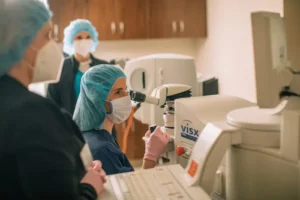Thinking about RLE surgery to clear up your vision but wondering if age could be a barrier? You’re not alone in this boat! Deciding on an eye surgery can be daunting, especially with age considerations. In this guide, we’ll unravel the mysteries of age and its relation to Refractive Lens Exchange (RLE) surgery. From understanding the procedure to comparing it with popular alternatives like LASIK, and finally answering the burning question: ‘Is there an age limit for RLE surgery?‘ – we’ve got it all covered. Dive in to make an informed decision about your vision’s future!
Contents
Understanding RLE Surgery
Refractive Lens Exchange, commonly known as RLE, is a cutting-edge vision correction procedure. Unlike LASIK, which reshapes the cornea, RLE involves replacing the eye’s natural lens with an artificial one, specifically tailored to correct vision issues. Primarily, it’s sought by individuals with extreme refractive errors or those not suitable for other treatments due to thin corneas or high prescriptions. While both LASIK and RLE aim for clearer vision, RLE offers a dual benefit: correcting refractive errors and eliminating the future possibility of cataracts by replacing the natural lens. It’s like getting a two-for-one deal in the world of vision correction!
The Ideal Age for RLE Surgery
Contemplating RLE surgery? Let’s break down the age-related considerations to make your decision clearer:
- Minimum Age Threshold: Technically, RLE can be performed at any age. However, it’s recommended to wait until one reaches at least 18 years old. This ensures that the eye’s prescription has largely stabilized, leading to more enduring surgical results.
- Presbyopia Strikes: As we sail towards the age bracket of 40 to 45 years, a common visual challenge emerges – presbyopia. This condition, a natural part of the aging process, makes focusing on nearby objects more difficult.
- LASIK’s Limitation: While LASIK is a popular vision correction procedure, it has its limitations. Specifically, it doesn’t negate the need for reading glasses that presbyopia introduces.
- RLE’s Comprehensive Solution: For those in the age group of 40-45 and beyond, RLE shines as the top choice. It doesn’t just rectify distance vision but also addresses near vision problems. By replacing the natural lens of the eye, it provides a holistic vision correction solution, eliminating the dependency on glasses.
In essence, if you’re inching towards or have crossed the mid-forties, RLE surgery offers a dual benefit for both near and far vision, making it a favorable option.
LASIK vs. RLE: A Comparative Age Analysis
When it comes to vision correction, LASIK and RLE are among the most sought-after procedures. However, age plays a significant role in determining which of these surgeries is more apt. Here’s a breakdown of how these procedures compare, particularly with age as a focal point:
- LASIK: Best for Younger Eyes
- Age Range: LASIK is commonly recommended for individuals between the ages of 18 and 40.
- Procedure’s Focus: LASIK primarily corrects refractive errors such as myopia, hyperopia, and astigmatism by reshaping the cornea.
- Limitations: As we age, especially post the age of 40, conditions like presbyopia set in. LASIK, while effective for distance vision, doesn’t address the age-related decline in near vision.
- RLE: A Boon for the Matured Eye
- Age Range: RLE becomes an attractive option for those above 40, particularly between 40 to 65 years.
- Procedure’s Focus: RLE replaces the natural lens of the eye, making it effective for both distance and near vision. It’s especially beneficial for those with presbyopia or early cataract signs.
- Versatility: RLE can be tailored to individual needs, offering monofocal, multifocal, or accommodating lens replacements, depending on the person’s vision requirements.
- Why RLE Over LASIK for Those Above 45?
- Dual Correction: RLE addresses both presbyopia and refractive errors, providing clarity for both near and far distances.
- Cataract Prevention: Since RLE involves lens replacement, it eliminates the possibility of cataract development in the replaced lens, offering a two-fold benefit.
In conclusion, while LASIK remains a popular choice for younger individuals looking to correct refractive errors, RLE stands out as the preferred procedure for older adults. It offers comprehensive vision correction, tackling age-related issues head-on.
Benefits of RLE Beyond Age Constraints
 Refractive Lens Exchange (RLE) has carved its niche in the realm of vision correction surgeries, and its advantages extend beyond just age-related considerations. While the procedure is popular among those in the older age bracket, its benefits are universal and cater to a broad spectrum of patients. Here’s a look at some of the salient features of RLE that make it a standout choice:
Refractive Lens Exchange (RLE) has carved its niche in the realm of vision correction surgeries, and its advantages extend beyond just age-related considerations. While the procedure is popular among those in the older age bracket, its benefits are universal and cater to a broad spectrum of patients. Here’s a look at some of the salient features of RLE that make it a standout choice:
- Comprehensive Vision Correction:
- Near and Far: One of the standout perks of RLE is its ability to correct both near and distance vision. This dual-action approach ensures that post-surgery, patients can enjoy a fuller range of clear vision.
- Astigmatism and Presbyopia: Beyond standard refractive errors, RLE can also address issues like astigmatism and presbyopia, further widening its corrective scope.
- Long-lasting Results:
- Unlike some vision correction procedures that might require touch-ups or adjustments as the years go by, RLE offers long-term clarity. Once the natural lens is replaced with an intraocular lens (IOL), the results are essentially permanent.
- Cataract Prevention:
- An added bonus of RLE is that it eliminates any future possibility of cataracts in the replaced lens. This preemptive measure ensures clearer vision in the golden years.
- Quick Recovery:
- RLE, despite its comprehensive approach, is known for its swift recovery times. Most patients can return to their regular routines within a few days, with many noticing improved vision almost immediately.
- Safety and Precision:
- Modern RLE surgeries leverage state-of-the-art technology, ensuring precision cuts, accurate lens placements, and minimized risks.
In essence, while age remains a factor in the decision to undergo RLE, the surgery’s holistic benefits make it a worthy consideration for anyone seeking comprehensive and lasting vision correction.
Potential Risks and Age Considerations
 Refractive Lens Exchange (RLE) is celebrated for its myriad benefits, but like any surgical procedure, there are inherent risks. Age plays a pivotal role in how these risks manifest and can be managed:
Refractive Lens Exchange (RLE) is celebrated for its myriad benefits, but like any surgical procedure, there are inherent risks. Age plays a pivotal role in how these risks manifest and can be managed:
- Retinal Detachment:
- Older patients might have a slightly increased risk of retinal detachment post-RLE. Regular check-ups post-surgery can aid in early detection and treatment.
- Endophthalmitis (Eye Infection):
- Although rare, there’s a risk of infection after the surgery. Elderly patients, with potentially weakened immune systems, should be particularly vigilant about following post-operative care instructions.
- Residual Refractive Error:
- Some patients, especially those with extreme prescriptions, might still require glasses for certain tasks. This likelihood can slightly increase with age due to the natural hardening of the lens.
- Posterior Capsule Opacification (PCO):
- Over time, the capsule holding the lens implant might become cloudy. This is more common in older adults but can be easily treated with a quick laser procedure.
To mitigate these risks, ensure:
- Regular post-operative check-ups.
- Strict adherence to prescribed medication and aftercare guidelines.
- Immediate consultation if any discomfort or anomalies are noticed.
Understanding and preparing for these potentialities ensures a smoother recovery and sustained vision clarity.
Conclusion
Deciding on an eye surgery is an important choice that affects one’s lifelong vision. Refractive Lens Exchange offers a promising solution, especially for those navigating the natural vision changes that come with age. Whether you’re just past 18 or have celebrated many more years, RLE could be your pathway to clearer, glasses-free vision. Don’t let age hold you back from experiencing the world in high definition.
Are you considering RLE surgery? Experience the freedom of pristine vision with RLE Surgery at EyeMantra. Don’t wait for tomorrow; start your journey to clear sight today. Book your free appointment now at 9711116605.



